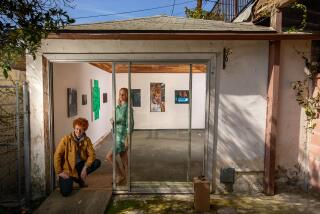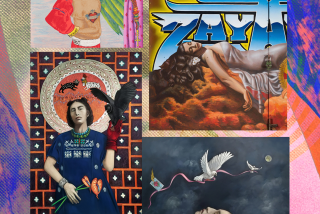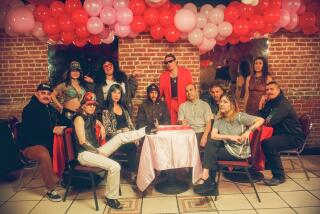Arts have been vital U.S.-Cuba link; the thaw will make them better
- Share via
When President Obama announced plans last week to restore diplomatic relations with Cuba, U.S. industries — from automotive to tourism — seemed elated by the possibility of being able to operate in Cuba. The news was greeted with just as much enthusiasm from the culture industry: “Art Collectors Predict ‘Stampede’ to Cuba,” read one newspaper headline, while another trumpeted: “Renewed ties hit a high note for Cuban music lovers.”
Grammy-winning producer, musician and composer Andres Levin, who is generally based in New York, happened to be in Havana for the announcement.
“It was extremely emotional,” he wrote via email from Cuba. “An air of hope and positive change was felt all over the city, from the streets to the offices. We’re still celebrating.”
The anticipated diplomatic thaw, along with a possible lifting or easing of the decades-long U.S. embargo, could transform how U.S. artists and cultural organizations can operate in Cuba — and how Cuban artists and their respective groups can work in the U.S.
“We don’t really know yet what will happen,” says the executive director of New York’s Bronx Museum, Holly Block, who by chance landed in Havana on the day the announcement was made. “But I think restrictions on cultural exchange projects will be a priority for both sides. Hopefully it won’t be as difficult for artists in Cuba to visit the U.S. and for us to get licenses to come here. It’s really exciting.”
Block, in fact, is in Havana because she’s trying to work out an exchange between her institution and Cuba’s Museo Nacional de Bellas Artes (MNBA; National Fine Arts Museum). The idea is that works from the Bronx Museum’s permanent collection will go on view at the MNBA during the 12th Havana Biennial, which opens in late May. This would be followed, in 2016, with a show of works from the Cuban museum’s collection in New York.
“As part of it, we’re bringing [artist] Mary Mattingly here for a project, so she’ll be here working on charettes and different workshops,” Block adds. “We’re also helping the museum start a teen program.”
It would appear that the politicos are finally getting around to doing what artists have been doing for years: that is, prying apart a hidebound piece of Cold War policy by finding opportunities to work together in ways that promote greater exchange between the two nations.
Though the U.S. embargo prohibits Americans from trading with Cuba, the Berman Amendment of 1988 (sponsored by former U.S. Rep. Howard Berman) allows the exchange of information, which includes records, photographs, songs, drawings and other art. This means that while it’s impossible to bring a box of Cuban cigars into the U.S. (a commercial product), it is possible to import a painting (information).
So even as U.S. and Cuban politicians have given each other the cold shoulder over the years, artists and arts organizations have found ways to connect.
In fact, there has been a long — if bureaucratically complicated — tradition of cultural exchange between Cuba and the U.S., one that ebbs and flows according to the politics of each Presidential administration. (The George W. Bush years were definitely an ebb.)
For years, Cuban artists have shown their work in U.S. museums, danced on U.S. stages and jammed in U.S. night clubs. The artist Kcho had a major exhibition of his work at the Museum of Contemporary Art here in Los Angeles in 1997; singer-songwriter Silvio Rodriguez played New York’s Carnegie Hall in 2010. And there have been countless other Cuban nationals hosted by U.S. venues, despite the embargo, including the singers of the Buena Vista Social Club, the grooving big band Los Van Van and the legendary ballerina Alicia Alonso.
In recent years, the traffic has gone the other way, with American artists, curators and producers regularly descending on Havana to scour the city for new talent.
The Havana Biennial, which is held in various locations around the Cuban capital every two to three years (it’s a biennial in name only), has become a pit-stop on the international art circuit, popping up on industry lists of must-see exhibitions.
This week, “Rent” will become the first Broadway production on the island in roughly 50 years. It is produced by Robert Nederlander Jr. (a member of renowned Broadway producing clan) and is directed by Andy Señor, a Cuban-American who starred in the original musical back in the 1990s. The show will run for three months and the entry fee will be 50 cents.
“It’s more about enjoyment and education than money,” Nederlander told the British daily the Telegraph.
The announcements by Obama and Castro won’t affect the particulars of any of these projects in progress. But the move does have many people in the cultural sphere considering what might be artistically possible between the two countries down the line.
“The first thing is that high-quality exhibitions of U.S. artists in Cuba is not something that they’ve been able to have very much of,” Block says. “The second thing that changes is that right now we’re only seeing some artists. Many Cuban artists have to go through Europe to get to the U.S. and have to wait a long time for permission to enter.”
Easier access for Cuban artists, says Block, will expand the range of Cuban art we can see in the U.S. The same goes for the music industry.
“There is a new generation of artists that are hungry,” says Levin, “while also blessed with extraordinary music preparation thanks to the education benefits.”
Levin, who is married to Cuban-born Latin fusion songstress Cucu Diamantes, has put together a number of events in Cuba in recent years. Last month, he staged the first-ever TEDx event in Havana, which was two years in the making. And, in 2010, he helped organize Diamantes’s tour of Cuba (he plays guitar in her band), which featured guest appearances from Cuban musicians such as trumpeter Alexander Abreu and the rumba band Los Muñequitos de Matanzas.
The tour also ended up turning into a collaboration with Cuban film director Jorge Perugorria (who starred in the Oscar-nominated “Strawberry and Chocolate” in the 1990s). Perrugoria used footage from the tour as part of a surreal, part-fictional love story called “Amor Crónico,” which was released earlier this year.
“Even though visits and licensed projects with Cuba have been possible for a few years now,” Levin says, “with wider possibilities, they will generate a lot more activity.”
As the Cuban government has eased restrictions on travel by its citizens, some prominent artists have taken to living abroad, especially in Europe, which has made it possible for them to be represented by American galleries. The Cuban art collective Los Carpinteros is part of the stable at Sean Kelly, the same New York gallery that represents Marina Abramovic. While Alexandre Arrechea, who last year dotted Manhattan with a series of architectonic sculptures, is on the roster at Magnan Metz, also based in New York.
Likewise, American art collectors, Cuban-American theater troupes, and musicians of all stripes have spent time in Cuba marinating in that country’s traditions. The loosening of restrictions can only mean further engagement and improved access to resources.
“This could open up foundation and support from individuals,” says the Bronx Museum’s Block. “And it would mean other funding sources to support art in Cuba.”
It would also mean that American expertise could be legally employed to help tackle significant problems — some of which have everything to do with culture. Havana, for example, is home to a world-class cluster of Modernist buildings, many of which are in dire need of skilled conservation work.
“If things opened up a bit, it means I can have an above-the-table dialog with my Cuban counterparts about what can be done,” says Rosa Lowinger, a Los Angeles-based art and architecture conservator who helped establish the Cuba travel program for the National Trust for Historic Preservation. “In the past, I’ve provided advice in a very informal way. But they can’t technically use my advice. And they can’t cite anything I suggest. A change [in policies] would mean an opportunity to work on a project together in a formal way.”
Lowinger was born in Cuba but has lived the vast majority of her life in the U.S. She has written about Cuba’s music, art and architecture quite extensively (most notably, in the 2006 book “Tropicana Nights: The Life and Times of the Legendary Cuban Nightclub”). She says the opportunities presented by the political shift are beyond exciting.
“The 20th century saw so much interaction between Cuba and the U.S.,” she says. “There was so much professional back and forth. A lot of the Cuban architects who built all the Modern architecture, they trained at [the Georgia Institute of Technology]. For me, its really about that connection. The two countries, at one point, were really so close.”
“That’s something a lot of people forget,” she adds. “In Havana, there is a lot of American history, too.”
Find me on Twitter @cmonstah.
More to Read
The biggest entertainment stories
Get our big stories about Hollywood, film, television, music, arts, culture and more right in your inbox as soon as they publish.
You may occasionally receive promotional content from the Los Angeles Times.











